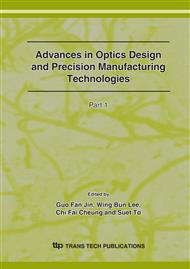p.333
p.340
p.346
p.351
p.358
p.364
p.371
p.377
p.383
The Wear Behavior of Pulse Current Electroforming Ni-P-SiC Composite Coatings
Abstract:
In this study, the SiC particles with a mean diameter of 300nm were used to be codeposited with Ni-P base to produce Ni-P-SiC composite coatings by means of the pulse current electroforming technology. The relationship between the SiC particles and phosphorous contents in the composite coatings has been constructed. The wear behavior of the Ni-P-SiC composite coatings was examined by that measurements data including the wear weight loss, the coefficient of friction, and the temperature increments under the wear tests, in which were correlated to the observation and analysis of the worn surface of the composite coatings. Experimental results show that the wear resistance of Ni-P-SiC composite coatings is superior to Ni-P composite coatings, if they are under the same level of hardness. In addition, the wear weight loss of Ni-P-SiC composite coatings is even about 62% less than that of Ni-P composite coatings, if they are based on the same production conditions. Further more, both the hardness and wear resistance of Ni-P-SiC composite coatings are superior to pure Ni coating, wherein its wear resistance is even up to 10 times better than that of pure Ni coating.
Info:
Periodical:
Pages:
358-363
Citation:
Online since:
December 2007
Authors:
Keywords:
Price:
Сopyright:
© 2008 Trans Tech Publications Ltd. All Rights Reserved
Share:
Citation:


